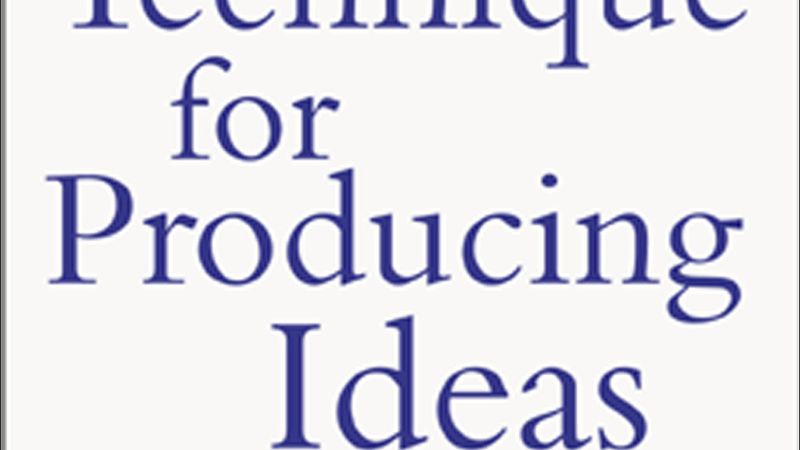BOOK LINK:
-
Young was approached by an advertising manager who wanted to shift their sales approach from selling ad space to selling ideas. However, the manager did not need to learn how to develop ideas.
-
Young outlines his process and experience developing advertising ideas over his career. He sees it as a learnable process rather than just random inspiration.
-
He advocates combining existing elements in new ways through a mental “digestive process.” Knowledge and experience provide the raw materials that get recombined through contemplation and thinking about a problem constantly.
-
The process stages involve immersing yourself in the problem through research, incubation where the subconscious works on it, insights emerging unexpectedly, and then consciously refining and developing the idea.
-
Experience and knowledge provide the “raw materials,” but ideas emerge through non-linear, intuitive thinking rather than direct linear logic. It is an internal mental process of recombination.
-
Young sought to demystify the process and show that while unpredictable, idea generation can be approached systematically through specific learned techniques rather than relying on flashes of genius. The key is actively engaging your mind in the problem.
-
The passage discusses how to get ideas by exploring the underlying processes and techniques. It acknowledges that having ideas seems mysterious but argues that there is a method to it.
-
It draws an analogy to how islands suddenly emerge from the sea, with ideas emerging similarly from the unconscious mind, resulting from unseen mental processes.
-
The key is identifying these idea-building processes so they can be consciously followed and developed into a technique or formula.
-
It explores whether everyone is capable of generating ideas or if there is an innate ability. It cites Pareto’s theory of “speculators” versus “rentiers” to argue that many people have an inherent capacity for new combinations.
-
Developing this capacity involves learning principles and methods. The most important principle is that ideas are new combinations of old elements, and the ability to see relationships between elements is crucial in combining them in novel ways.
-
The summary focuses on outlining the passage’s main points around exploring the underlying processes of idea generation and arguing that there is a method that can be learned.
David Riesman’s book “The Lonely Crowd” provides valuable insights into consumerism and advertising, even though it is not directly about advertising. The book examines how social and cultural changes in post-World War 2 America led to a new societal pattern called “other-direction,” where people oriented their lives and identities around their peers rather than inward values or traditions.
This analysis inadvertently shed light on critical aspects of advertising, such as the importance of belonging, peer approval, and conforming to perceived social norms. As America shifted to a more consumerist society after the war, advertising effectively tapped into these new societal pressures and desires to belong. Therefore, while not directly focused on advertising, Riesman’s examination of broader cultural shifts made “The Lonely Crowd” a more insightful book about the psychology of consumers and how advertising could appeal to them, compared to books that only narrowly discussed advertising techniques.
-
The idea generation process involves four stages: 1) Gathering materials and information, 2) Thinking deeply about the problem, 3) Letting your unconscious mind work on it by forgetting about it temporarily, 4) The idea suddenly appearing when not focusing on it directly.
-
In stage 3, it is essential to stimulate your imagination by engaging in enjoyable activities like music, movies, reading fiction, etc. This helps the unconscious work on the problem.
-
Ideas often appear unexpectedly, like when waking up or in unrelated activities. Constant direct thinking is less effective than periods of rest and indirect stimulation.
-
After an idea appears, it needs refinement by subjecting it to criticism from others and adapting it to practical constraints. Many good ideas fail at this stage.
-
Building a rich reservoir of general knowledge and life experiences provides material for ideas to emerge from. Constant learning of new topics fuels new idea generation.
-
While some appear to generate ideas effortlessly, for most, it is a learned process of systematically gathering inputs, conscious/unconscious thinking, and refinement over time.
-
Wallas identified four stages of the idea-producing process: preparation, incubation, illumination, and verification. In preparation, the thinker consciously studies the problem. Incubation follows, which is an unconscious processing period. Insights then occur during illumination. Lastly, ideas are verified and worked out consciously.
-
Poincaré emphasized that the incubation period is vital for creativity. During this unconscious stage, ideas ferment and combine unconsciously in new ways. Many insights reportedly occurred during relaxation, e.g., in the shower.
-
Poincaré and Wallas noted that the essential ideas do not seem to result from deliberate, labored logical thought. Instead, they appear as sudden illuminations after prolonged preparation and incubation.
-
Beveridge highlighted how scientists often follow hunches and intuitions during investigations, not just logical reason. Insight and intuition guide discovery as much as deduction.
-
All three works stressed that creativity results from conscious and unconscious thought interplay over time. Prolonged preparation, letting the mind wander during incubation, and being open to intuitions were seen as conducing to novel insights.

About Matheus Puppe

